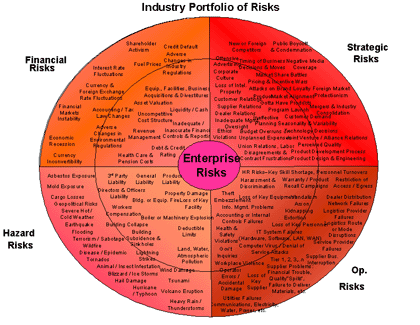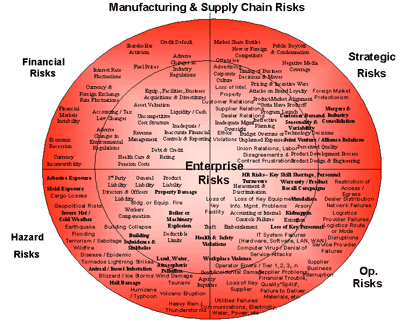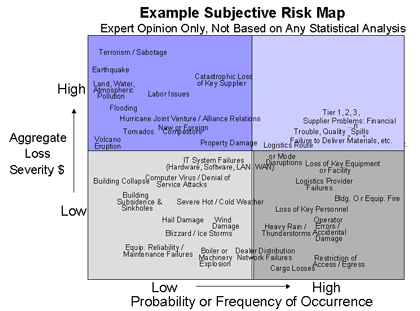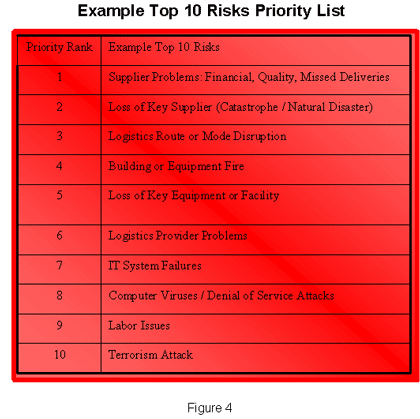|
By Debra Elkins,
Devadatta M. Kulkarni, and
Jeffrey Tew
Manufacturing Systems Research Lab
General Motors R&D Center
30500 Mound Road, Mailcode 480-106-359
Warren, MI 48090
1 Introduction
While Enterprise Risk Management (ERM) continues to gain
acceptance in the financial services industry as a means
to address credit, market and operational risks, and improve
performance of business operations, other industrial sectors
have lagged behind in adopting a true enterprise-wide view
of risks. Firms are now realizing that global sourcing and
just-in-time lean manufacturing, while yielding significant
cost savings, may have also increased their risk exposure
to global risks. Now, with minimal inventory levels and efficient
utilization of production capacity, the traditional buffers
against disruptions are no longer available. To respond to
this new competitive environment, businesses are beginning
to enhance their current capabilities in managing global
risks and mitigating impacts of disruptions. We offer some
thoughts and comments on how companies can get started in
rapidly identifying and assessing manufacturing and supply
chain risks to enhance their operational awareness and responsiveness
to risk events.
Step 1: Assemble a Cross-functional Team of Risk Experts
An extended team of experts from across an organization
should be selected to help with rapid and thorough identification
of risks. Team members can be chosen from among risk managers,
statistical analysts, operations research analysts, manufacturing
engineers, purchasing staff buyers, commodity experts, supply
chain and logistics managers, operations IT systems experts,
etc. Each team member is expected to represent their business
unit and assist with identifying and gathering quantitative
and qualitative risk data. Traditionally in most large organizations,
risk management as an expertise has a corporate home in insurance
and risk financing or audit services. However, the real
risk owners for manufacturing and supply chain risks are
in operations.
Thus, we advocate that the team must include subject matter
experts from business operations who have handled many of
these supply chain and manufacturing disruptions in the past.
These operations specialists can contribute significantly
in identifying risks and explaining event severity from an
operations perspective.
Among the team, there has to be a core team of “risk
evangelists,” who must take up the challenge to promote
risk awareness across the entire enterprise, share risk management
and mitigation successes, document and convey lessons learned,
and leverage knowledge and experience to embed risk management
in operations business processes. Early on in the process,
the team should also obtain top management support and a
management champion to help overcome organizational roadblocks,
and drive improvements in operational awareness and responsiveness
to risk events.
Step 2: Convene the Cross-functional Team for Brainstorming
to Identify and Map a Portfolio of Enterprise Risks
In Figure 1, we show a portfolio map of enterprise risks
that is a possible outcome of such a brainstorming exercise.
The portfolio spans financial, strategic, hazard, and operational
risks. These four categories are chosen, as they are typically
how risk management responsibilities have been divided and
assigned to different business units in many large corporations.
A simple high level risk categorization used in the map allows
executives and mid-level managers to readily engage in the
process of editing the map as well as identifying or taking
ownership of some of the risks from the portfolio. This portfolio
is an excellent starting place for manufacturing engineers
and supply chain analysts to begin identifying risks that
would affect their work, or they could impact through their
operations responsibilities. Note that the portfolio needs
to include all possible enterprise risks that the team can
identify. Capturing this full portfolio is important, for
it demonstrates to top leadership that the team has been
as thorough as possible in identifying risks. The portfolio
will be a key tool for risk awareness discussions, for it
encourages groups to talk openly about risks they can control,
manage, or mitigate, and those risks that are outside their
spheres of influence.

figure 1
click for larger image
Step 3: Filter, Assess and Prioritize Risks
Once the risk portfolio is defined and agreed upon, the
next step is to have the team filter down the broad portfolio
to those risks that are relevant to manufacturing and supply
chain operations. Figure 2 shows the subset of risks in bold
on the portfolio that a group might identify as manufacturing
and supply chain risks. This exercise can generate valuable
discussion on ownership of some of the risks, recognition
that some risks do not have clear owners, and help the team
to build a common understanding of the breadth of the company’s
portfolio of risks.

figure 2
click for larger image
Once the subset portfolio of manufacturing
and supply chain risks is identified, the next task is to
construct a subjective
risk map or “heat map” for the manufacturing
and supply chain risks, and classify risks based on probability
of occurrence and loss severity (see Figure 3). Without collecting
much statistical data, the team can subjectively place risks
in the quadrants, and openly discuss which risks could most
impact manufacturing and supply chain operations. Note that
the loss severity assessment should also intuitively include
how difficult and costly each risk is to mitigate.

figure 3
click for larger image
Further division of the probability of occurrence into 4
categories (such as very unlikely, improbable, probable,
very probable), and the loss severity into 4 categories (such
as insignificant, minor, serious, catastrophic) can help
clarify and distinguish among the different manufacturing
and supply chain risks in terms of their overall impact.
This refined classification will help the team to recognize
the relative difference across all risks in terms of occurrence
and severity, and help them arrive at a prioritized list
in view of organizational metrics (both business unit metrics
and overall enterprise metrics).
This subjective risk map can guide allocation
of scarce resources (people, time, money) to subsequent risk
modeling and analysis
efforts. Once the prioritized risk map has been developed,
the team can naturally create a Top-10 priority list
of risks (see Figure 4). The exercise of constructing a Top-10
list is important. As they start to form the Top-10 priority
list, the team may have to revisit and adjust their probability
and severity assessments on the risk map.

Step 4: Begin to Work on “Actionable Risks” and “Integrate
Learnings” into Business Processes
Management can use this proposed approach to prioritize
manufacturing and supply chain risks that can be strategically
influenced or managed over time. We note that some risks
are “out there” but nothing can be done about
them. Managers should acknowledge these risks, and move on
to other risks that are actionable. Secondly, enhancing risk
management in manufacturing and supply chain operations amounts
to changing organizational culture and priorities. This type
of change has the promise of making operations more resilient
and responsive to the dynamic environment, but cannot be
achieved overnight. The risk maps and models can help multiple
stakeholders visualize and comprehend cost-benefit tradeoffs
of various mitigation efforts and impact on the overall enterprise.
Risk management for manufacturing and supply chains is adopted
in an evolutionary (rather than revolutionary) manner, because
manufacturing and supply chains typically evolve over time,
and sudden interruptions for the sake of better risk management
can affect morale of the organization significantly. Management
should periodically revisit the prioritized heat map of risks
along with the top-10 risks to update actionable and urgent
risks, and monitor how the firm is doing in enhancing operational
responsiveness to manufacturing and supply chain risks.
Key Takeaways for the Supply Chain Professional
- Utilize a cross-functional team to identify risks.
- Be
thorough in identifying enterprise risks.
- Don’t
get lost in too much data collection to assess probability
and severity of risks. Subjective risk
assessment
is a quick way to get started with ranking risks.
- Prioritize
focus to the key manufacturing and supply chain risks.
- Empower
business units to take ownership of managing risks.
- Work on actionable risks and integrate learnings into
operational business processes.
Acknowledgements
Numerous people inside and outside General Motors have helped
improve our understanding of manufacturing and supply chain
risks. To avoid leaving anyone out, we acknowledge them as
a group, and gratefully thank them for their time, collaboration,
and valuable insights. The paper is also based on a number
of invited talks given at technical conferences and universities
during 2002 and 2003.
Author Biographies
Debra Elkins, Ph.D. is a Senior Research Engineer with General
Motors R&D Center in Warren, Michigan. She is the technical
lead researcher developing probabilistic and enterprise models
for strategic manufacturing and supply chain risk analysis.
Debra received her Ph.D. in Industrial Engineering – Operations
Research from Texas A&M University.
Devadatta (“Datta”) M. Kulkarni, Ph.D. is a
Staff Research Engineer with General Motors R&D Center
in Warren, Michigan. Prior to joining GM, he spent 15 years
as a Professor of Mathematics at Oakland University. He has
applied risk-adjusted decision making methodologies in the
areas of product development, manufacturing and supply chain
to develop decision support systems for distributed strategic
decisions. Datta received his Ph.D. in Mathematics from Purdue
University.
Jeffrey Tew, Ph.D. is Group Manager for Manufacturing Enterprise
Modeling at the General Motors R&D Center. Jeff has over
20 years of industry experience in supply chain and logistics
modeling and analysis. Jeff received his Ph.D. in Industrial
Engineering from Purdue University and is a diehard Boilermaker
fan.
©2004
ChainLink Research, Inc.
|


























